ICSE Biology Previous year Question Paper 2018 Solved for Class 10
General Instructions:
- Answers to this Paper must be written on the paper provided separately.
- You will not be allowed to write during the first 15 minutes.
- This time is to be spent in reading the Question Paper.
- The time given at the head of this paper is the time allowed for writing the answers.
- Attempt all questions from Section I and any four questions from Section II.
- The intended marks for questions or parts of questions are given in brackets [ ].
Section-I [40Marks]
(Attempt all questions from this section)
Question 1.
(a) Name the following: [5]
(i) The organization which procures and supplies blood during an emergency.
(ii) The blood vessel which supplies blood to the liver.
(iii) The number of chromosomes present in a nerve cell of a human being.
(iv) The layer of the eyeball that forms the transparent Cornea.
(v) The wax-like layer on the epidermis of leaves which reduces transpiration.
Answer:
(i) Red cross
(ii) Hepatic artery [Hepatic Portal Vein can also be the answer because the type of blood is not specified].
(iii) 46 [This part of the question must not be under name the following].
(iv) Sclera / sclerotic layer / sclerotic coat / scleroid
(v) Cuticle
(b) Choose the correct answer from each of the four options given below: [5]
(i) The number of Spinal nerves in a human being are :
A. 31 pairs
B. 10 pairs
C. 21 pairs
D. 30 pairs.
Answer:
A. 31 pairs
(ii) Which one of the following is non-biodegradable?
A. DDT
B. Vegetable peel
C. Cardboard
D. Bark of trees
Answer:
(ii) DDT
(iii) Aqueous humour is present between the :
A. Lens and Retina
B. Iris and Lens
C. Cornea and Iris
D. Cornea and Lens
Answer:
D. Corena and Lens
(iv) A strong chemical substance which is used on objects and surfaces in our surroundings to kill germs :
A. Cresol.
B. Carbolic arid
C. Iodine
D. Mercurochrome
Answer:
A. Cresol
(v) Which one of the following is a Greenhouse gas?
A. Oxygen
B. Methane
C. Sulphur dioxide
D. Nitrogen
Answer:
B. Methane
(c) Complete the following paragraph by filling in the blanks (i) to (v) with appropriate words: [5]
To test a leaf for starch, the leaf is boiled in water to (i)________. It is then boiled in Methylated spirit to (ii) ________.The leaf is dipped in warm water to soften it. It is placed in a petri dish, and (iii) ___________. solution is added. The region of the leaf which contains starch, turns (iv) _________. and the region which does not contain starch, turns (v) _________.
Answer:
(i) to kill the cells / destroy the enzymes
(ii) Remove chlorophyll / to decolourize it
(iii) Iodine
(iv) Blue black
(v) Brown/yellow
(d) Match the items given in Column A with the most appropriate ones in Column B and rewrite the correct matching pairs. [5]

Answer:

(e) CorrectThefollowing statements by changing the underlined words : [5]
(i) Normal pale yellow colour of the urine is due to the presence of the pigment Melanin.
(ii) The outermost layer of Meninges is Pia mater.
(iii) The cell sap of root hair is Hypotonic.
(iv) Xylem transports starch from the leaves to all parts of the plant body.
(v) Nitrogen bonds are present between the complementary nitrogenous bases of DNA.
Answer:
(i) Urochrome
(ii) Dura mater
(iii) Hypertonic
(iv) Pholem
(v) Hydrogen
(f) Choose between the two options to answer the question specified in the brackets for the following: [5]
An example is illustrated below.
Example: Corolla or Calyx (Which is the outer whorl ?) Answer: Calyx
(i) Blood in the renal artery or renal vein (Which one has more urea?)
(ii) Perilymph or endolymph (Which one surrounds the organ of Corti?)
(iii) Lenticels or stomata (Which one remains open always?)
(iv) Sclerotic layer or choroid layer (Which one forms the his?)
(v) Blood in the pulmonary artery or pulmonary vein (Which one contains less oxyhaempglobin?)
Answer:
(i) Blood in renal artery
(ii) Endolymph
(iii) Lenticels
(iv) Blood in pulmonary artery
(v) Air pollution
(g) Given below is a representation of a type of pollution. [5]
Study the picture and answer the questions :

(i) Name the type of pollution shown in the picture.
(ii) Name one source of this pollution.
(in) How does this pollution affect human health?
(iv) Write one measure to reduce this pollution.
(v) State one gaseous compound that leads to the depletion of the ozone layer and creates’Ozone holes’.
Answer:
(i) Air pollution
(ii) Smoke from vehicles / harmful gases from industries
(iii) so2 causes bronchitis, Lead causes blood cell shortage, Smog leads to asthma and poor visibility, Oxides of nitrogen decreases oxygen carrying capacity of blood.
(iv) Use of lead free petrol and CNG
(v) Chloroflourocarbon
(h) Choose the ODD one out from the following terms given and name the CATEGORY to which the others belong: [5]
Example: Nose, Tongue, Arm, Eye
Answer: Odd Term – Arm, Category – Sense organs.
(i) Detergents, X-rays, sewage, oil spills
(ii) Lumen, muscular tissue, connective tissue, pericardium
(iii) Dendrites, Medullary Sheath, Axon, Spinal cord
(iv) Centrosome, Cell wall, Cell membrane, Large vacuoles
(v) Prostate gland, Cowper’s gland, seminal vesicle, seminiferous tubules.
Answer:
(i) Odd term – X rays, Category – Water pollution
(ii) Odd term – Pericardium, Category – Parts of blood vessels
(iii) Odd term – Spinal cord, Categoiy – Parts of Neuron
(iv) Odd term – Centrosome, Category – Parts of plant cejl
(v) Odd term – Seminiferous tubule, Category – Accessory glands of male reproductive system
Section – II (40 Marks)
(Attempt any four questions from this section)
Question 2.
(a) The diagram given below represents a stage during cell division. Study the same and answer the questions that follow :
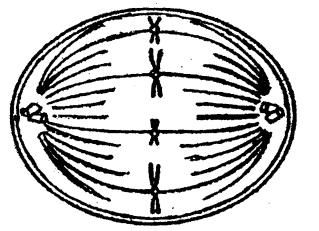
(i) Identify whether it is a plant cell or an animal cell. Give a reasop in support of your answer.
(ii) Name the stage depicted in the diagram.
What is the unique feature observed in this stage?
(iii) Name the type of cell division that occurs during :
- Replacement of old leaves by new ones.
- Formation of gametes.
(iv) What is the stage that comes before the stage shown in the diagram ?
(v) Draw a neat, labelled diagram of the stage mentioned in (iv) above keeping the chromosome number constant.
Answer:
(i) Animal cell. Centriole is present. [It can be a plant cell also as it is double layered (cell wall present) and astral rays are absent].
(ii) Metaphase. Unique feature is chromosomes are arranged at the equatorial plate (metaphasic) plate.
(iii)
- Mitosis
- Meiosis
(iv) Prophase
(v)
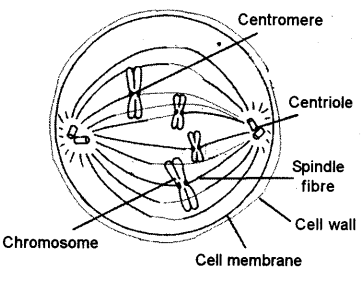
(b) Mention the exact location of the following: [5]
(i) Epididymis
(ii) Lacrimal gland
(iii) Malleus
(iv) Hydathodes
(v) Pulmonary semilunar valve
Answer:
(i) A knot like structure in the upper portion of testes
(ii) Upper side portion of the orbit of eye
(iii) Middle ear attached to tympanum and incus
(iv) Margin of leaves
(v) Opening of right ventricle into pulmonary artery
Question 3.
(a) Given below are diagrams showing the different stages in the process of fertilisation of an egg in the human female reproductive tract. [5]
Study the diagrams and answer the questions :

(i) Arrange the letters given below each diagram in a logical sequence to show the correct order in the process of fertilisation.
(ii) Where does fertilisation normally take place? What is ‘Implantation’ that follows fertilisation?
(iii) Mention the chromosome number of the egg and zygote in humans.
(iv) Explain the term’Gestation’. How long does Gestation last in humans?
(v) Draw a neat, labelled diagram of a mature human sperm.
Answer:
(i) DCBA [It can also be CBAD as there is not a clear difference between egg cell and zygote]
(ii) In the fallopian tube (Oviduct). Attachment of blastocyst/embryo/ fertilized ovum in the uterine wall (endometrium) of mother.
(iii) Egg-23 Zygote – 46
(iv) Duration of embryonic development in the uterus starting from implantation upto the birth of a child. Gestation lasts in human for 280 days.
(v)
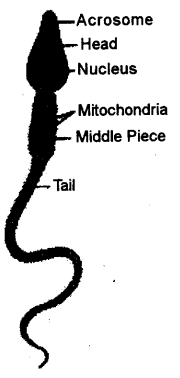
(b) A potted plant with variegated leaves was taken in order to prove a factor necessary for photosynthesis. The potted plant was kept in the dark for 24 hours and then placed in bright sunlight for a few hours. Observe the diagrams and answer the questions. [5]

(i) What aspect of photosynthesis is being tested in the above diagram?
(ii) Represent the process of photosynthesis in the form of a balanced equation.
(iii) Why was the plant kept in the dark before beginning the experiment?
(iv) What will be the result of the starch test performed on leaf ‘A’ shown in the diagram? Give an example of a plant with variegated leaves.
(v) Draw a neat labelled diagram of a chloroplast.
Answer:
(i) Chlorophyll is necessary for photosynthesis
(ii)

(iii) To destarch the leaves
(iv) The green part of the leaf turns blue black and the pale yellow part will turn brown with iodine solution at the end of starch test.
Examples: Coleus/Geranium/Croton/Tradescantia
(v)
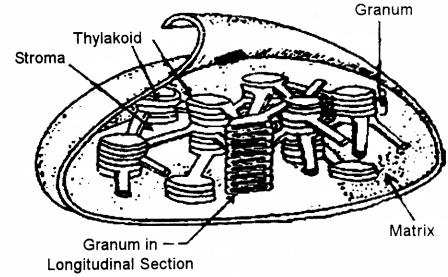
Question 4.
(a) The diagram given below shows the internal structure of a spinal cord depicting a phenomenon. Study the diagram and answer the questions : [5]

(i) Name the phenomenon that is depicted in the diagram. Define the phenomenon.
(ii) Give the technical term for the point of contact between the two nerve cells.
(iii) Name the parts numbered 1, 2 and 3.
(iv) How does the arrangement of neurons in the spinal cord differ from that of the brain?
(v) Mention two ways by which the spinal cord is protected in our body.
Answer:
(i) Reflex action. Reflex action is a spontaneous, involuntary and automatic response to any stimulus without the involvement of brain.
(ii) Synapse
(iii)
- Sensory neuron
- Motor neuron
- Grey mater
(iv) In brain, grey mater is outside and white mater is inside.
In spinal cord, grey mater is inside and while mater is outside
(v) Meninges and Vertebral column
(b) Give appropriate biological or technical terms for the following : [5]
- Process of maintaining water and salt balance in the blood.
- Hormones which regulate the secretion of other endocrine glands.
- Movement of molecules of a substance from their higher concentration to lower concentration when they are in direct contact.
- The condition in which a pair of chromosomes carry similar alleles of a particular character.
- The complex consisting of a DNA strand and a core of histones.
- The onset of menstruation in a young girl.
- Squeezing out of white blood cells from the capillaries into the surrounding tissues.
- The fluid which surrounds the foetus.
- The relaxation phase of the heart.
- The difference between the birth rate and the death rate.
Answers:
- Osmoregulation
- Tropic hormone
- Diffusion
- Homozygous
- Nucleosome
- Menarche
- Diapedesis
- Amniotic fluid
- Diastole
- Growth rate of population
Question 5.
(a) The diagram given below is that of a structure present in a human Kidney study the same and answer the questions that follow: [5]
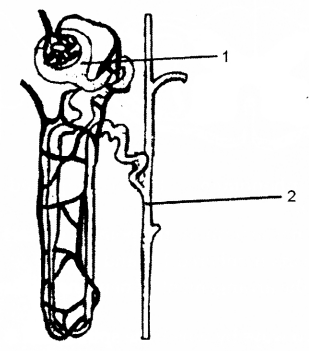
(i) Name the structure represented in the diagram.
(ii) What is the liquid entering part’ 1′ called?
Name two substances present in this liquid that are reabsorbed in the tubule.
(iii) What is the fluid that comes to part ‘2’ called? ,
Name the main nitrogenous waste in it.
(iv) Mention the three main steps involved in the formation of the fluid mentioned in (in) above.
(v) Name the substance which may be present in The fluid in part ‘2’ if a person suffers from Diabetes mellitus.
Answer:
(i) Nephron / Uriniferous tubule
(ii) Glomerular filtrate. Glucose and water soluble salts
(iii) Urine; Urea
(iv)
- Ultrafiltration
- Selective reabsorption
- Tubular secretion
(v) Glucose
(b) Differentiate between the following pairs on the basis of what is indicated in the brackets. [5]
(i) Leaf and Liver [ form in which glucose is stored]
(ii) ATP and AIDS [expand the abbreviations]
(iii) Testosterone and Oestrogen [organ which secretes]
(iv) Ureter and Urethra [function]
(v) Hypotonic solution and Hypertonic solution [condition of a plant cell when placed in them]
Answer:

Question 6.
(a) Given below is a diagram of a human blood smear study the diagram and answer the questions that follow: [5]
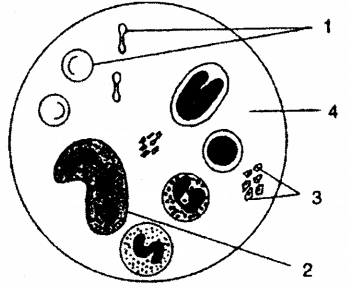
(i) Name the components numbered ‘V to ‘4’.
(ii) Mention two structural differences between the parts ‘1’ and ‘2’.
(iii) Name the soluble protein found in part ‘4’ which forms insoluble threads during dotting of bipod.
(iv) What is the average lifespan of the component numbered T?
(v) Component numbered “V do not have certain organelles hut are very efficient in their funcLion. Explain.
Answer:
(i)
- Red blood t ells / Erythrocytes
- White blood cells / Leucocytes
- Platelets / Thrombocytes
- Blood plasma
(ii)

(iii) Fibrinogen
(iv) 140 days
(v) Loss of Nucleus increases their surface area for absorbing more oxygen, loss of mitochondria means RBCs cannot use oxygen for themselves and loss of endoplasmic reticulum increases flexibility of RBCs for their movement through narrow capillaries.
(b) Give biological explanations for the following : [5]
(i) Education is very important for population control.
(ii) The placenta is an important structure for the development of a foetus.
(iii) All the food chains begin with green plants.
(iv) Plants growing in fertilized soil are often found to will if the soil is not adequately watered.
(v) We should not put sharp objects into our ears.
Answer:
(i) Helps people know about family planning and consequences of having large families.
(ii) Placenta allows diffusion of substances like oxygen, COz, hormones, nutrients, excretory products, etc. from the mother to the foetus or from foetus to the mother.
(iii) All food chains begin with green plants as they manufacture food for all living organisms by photosynthesis.
(iv) Water makes the roots and all parts of plants turgid and their deficiency may lead to wilting of these parts.
(v) Tympanum is very delicate and sharp object may rupture them leading to deafness.
Question 7.
(a) The diagram below represepts a process in plants. [5]
The setup was placed in bright sunlight. Answer the following questions :
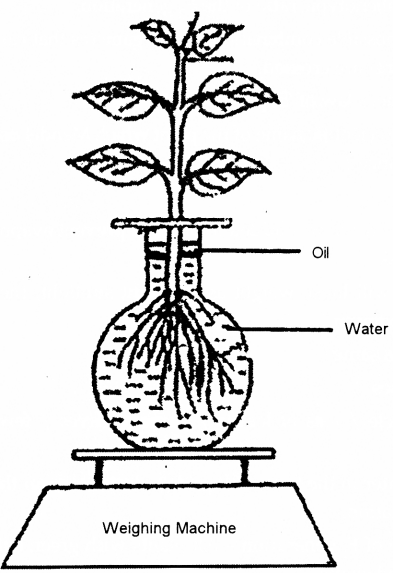
(i) Name 6the physiological process depicyed in the diadram
Why was oil added to the water?
(ii) When placed in bright sunlight for four hours, what do you observe with regard to the initial and final weight of the plant?
(iii) What happens to the level of water when this setup is placed in:
- Humid conditions?
- Windy conditions?
(iv) Mention any three adaptations found in plants to overcome the process mentioned in (i).
(v) Explain the term Guttation.
Answer:
(i) Transpiration. Oil was added in order to prevent evaporation from the round bottom flask.
(ii) The plant will loose weight as in bright sunlight, the rate of transpiration will he maximum.
(iii)
- Remains same
- Decreases
(iv) Thick cuticle/loss of leaves / narrow leaves / fewer stomata / sunken stomata
(v) Loss of water in the form of liquid as droplets from the margins of leaves is called guttation.
(b) A pea plant which is homozygous for Green pods which are inflated [GG1I] is crossed with a homozygous plant for yellow pods which are constricted [ggii]. Answer the following questions: [5]
(i) Give the phenotype and genotype of the F, generation.
Which type of pollination has occurred to produce Fj generation?
(ii) Write the phenotypic ratio of the F2 generation.
(iii) Write the possible combinations of the gametes that can be obtained if two F1 hybrid plants are crossed.
(iv) State Mendel’s law of ‘Segregation of Gametes’.
(v) What is the scientific name of the plant which Mendel used for his experiments on inheritance ?
Answer:
(i) Phenotype of F1 generation – All plants with green coloured pods and with inflated pod shape
Genotype of F1 generation – All plants with Ggli.
Cross pollination
(ii) 9 : 3 : 3 : 1
(iii) Possible combinations of gametes are as follows GI, Gi, gl, gi
(iv) The two factors or genes controlling one character separate or segregate without blending or influencing each other during the formation of gametes so that each gamete receives one factor or gene for each character.
OR
Two members of a pair of factors separate during the formation of gametes.
(v) Pisum sativum
